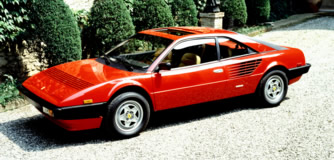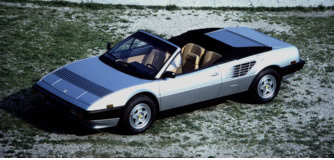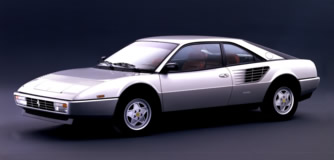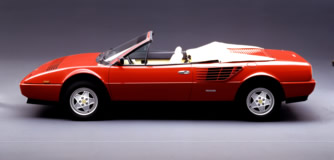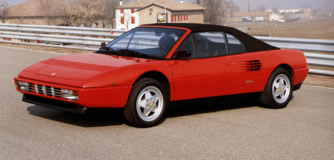|
The Pininfarina styling was slightly revised, making it even more elegant, and bifocal headlights were fitted to substantially increase beam intensity.
The Mondial t cabriolet was announced
concurrently with coupé version in 1989, and similarly was the most radical overhaul of the model during its production run. The engine capacity increased to 3.4 litres and it became longitudinally mounted, instead of
transversely on the previous models. It was coupled to a transverse gearbox, hence the letter "t" in the model designation, and had an ABS braking system as standard equipment, whilst the front and rear tracks
increased by 2mm and 50mm respectively. At the front, the paired retractable headlight units of the previous models were replaced by neater retractable rectangular homofocal units. The large trapezoidal rear wing air intakes
disappeared, being replaced by smaller neat rectangular louvres on the rear wings, which were of a more bulbous profile, providing a more muscular stance to the car. As on the Mondial 3.2, the tail badge did not differentiate
between the coupé or the cabriolet, simply stating Mondial t. As with the previous model changes the interior was once again modified, this time comprehensively, including a revised instrument nacelle, centre console,
upholstery pattern and the facility for the rear seat backrests to fold flat to create a luggage platform. A leather finished dashboard was available as an option, as was a leather soft top cover.
The main European
market Mondial t cabriolet models had a tubular chassis with a factory type reference F 108 AL/DN. As with the coupé it featured a bolted rear sub-frame section, so that the complete engine, transmission and rear suspension
assembly could be removed as a single unit, for ease of maintenance.
The longitudinally mid mounted V8 engine of 3405cc capacity, with a bore and stroke of 85mm x 75mm, was mated to a transverse five speed all
synchromesh gearbox. The enlarged engine was provided with dry sump lubrication, and had factory type reference number F 119 DL and later F 119 G. It was initially fitted with a Bosch M2.5 and then later an M2.7 Motronic
combined injection/ignition system, to produce a claimed power output of 300bhp at 7200rpm for the first main European market series, and 295bhp for the later series with the M2.7 Motronic ignition unit and catalytic convertors
in the exhaust system. As with other models in the Mondial series, the Mondial t was provided with independent suspension via wishbones, coil springs and hydraulic shock absorbers all round, with front and rear anti roll bars.
In addition it was fitted with power steering plus electronically controlled shock absorbers, that gave either hard, medium or soft settings, from a driver actuated switch. Towards the end of the production run a Valeo
electronically actuated clutch became available as an option, which gave the facility of normal manual gear changes without using a clutch pedal.
As with the concurrent 2 seat models right and left hand drive was
available, together with various world market specification models. From chassis number 75000, both odd and even numbers were used for the road production cars, thus, as all Mondial t cabriolets were produced post this number
they have both odd and even chassis numbers. The Mondial t cabriolet was produced between 1989 and 1993, with a total of 1017 examples made in the chassis number range 80339 to 97733.
Model Specification
- Mondial T Coupe and Cabriolet (1989-1993)
Engine
Type...............................rear, longitudinal 90° V8
Bore/stroke.......................85 x 75 mm
Unitary displacement..........425.59 cc
Total displacement.............3404.70 cc
Compression ratio..............10.4:1
Maximum power.................221 kW (300 hp) at 7200 rpm
Power per litre..................88 hp/l
Maximum torque................324 Nm (33 kgm) at 4200 rpm
Valve actuation.................twin overhead camshafts per bank, four valves per cylinder
Fuel feed..........................Bosch Motronic M2.5 electronic injection
Ignition............................Bosch M2.5 static electronic, single spark plug per cylinder
Lubrication.......................dry sump
Clutch.............................twin-plate
Chassis
Frame..............................tubular steel
Front/Rear suspension........independent, unequal-length wishbones,
coil springs over gas-filled telescopic shock absorbers,
anti-roll bar
Brakes.............................discs
Transmission.....................5-speed + reverse
Steering...........................rack-and-pinion
Fuel tank.........................capacity 86 litres
Front tyres.......................205/55 ZR 16
Rear tyres........................225/55 ZR 16
Bodywork
Type...............................2+2 coupé or 2+2 cabriolet
Length.............................4535 mm
Width..............................1810 mm
Height.............................1235 mm
Wheelbase.......................2650 mm
Front track.......................1522 mm
Rear track........................1560 mm
Weight............................1426 kg (dry) coupé
1468 kg (dry) cabriolet
Performance
Top speed........................255 km/h
Acceleration 0-100 km/h.....6.3 sec
0-400 m...........................14.3 sec
0-1000 m.........................25.8 sec
- 3.2 Mondial coupé and Cabriolet (1985-1989)
Engine
Type...............................rear, transverse, 90° V8
Bore/stroke.......................83 x 73.6 mm
Unitary displacement..........398,22 cc
Total displacement.............3185.76 cc
Compression ratio..............9.8 : 1
Maximum power.................199 kW (270 hp) at 7000 rpm
Power per litre..................85 hp/l
Maximum torque................304 Nm (31 kgm) at 5500 rpm
Valve actuation.................twin overhead camshafts per bank, 4 valves per cylinder
Fuel feed..........................Bosch K-Jetronic mechanical injection
Ignition............................Marelli Microplex electronic, single spark plug per cylinder
Lubrication.......................wet sump
Clutch.............................single-plate
Chassis
Frame..............................tubular steel
Front/Rear suspension........independent, unequal-length wishbones,
coil springs over telescopic shock absorbers,
anti-roll bar
Brakes.............................discs
Transmission.....................5-speed + reverse
Steering...........................rack-and-pinion
Fuel tank.........................capacity 80 litres
Front tyres.......................205/55 VR 16
Rear tyres........................225/55 VR 16
Bodywork
Type...............................2+2 coupé or 2+2 cabriolet
Length............................4535 mm
Width..............................1795 mm
Height.............................1235 mm Coupe
1265 mm 2+2 cabriolet
Wheelbase........................2650 mm
Front track.......................1520 mm
Rear track........................1510 mm
Weight............................1410 kg (dry) coupé
1400 kg (dry) 2+2 cabriolet
Performance
Top speed........................250 km/h
Acceleration
0-100 km/h......................7.4 sec
0-400 m..........................14.6 sec
0-1000 m.........................27.2 sec
- Mondial Cabriolet (1983-1985)
Engine
Type...............................rear, transverse, 90° V8
Bore/stroke.......................81 x 71 mm
Unitary displacement..........365.86 cc
Total displacement.............2926.90 cc
Compression ratio..............9.2 : 1
Maximum power................176 kW (240 hp) at 7000 rpm
Power per litre...................82 hp/l
Maximum torque................260 Nm (26.5 kgm) at 5000 rpm
Valve actuation.................twin overhead camshafts per bank, four valves per cylinder
Fuel feed..........................Bosch K-Jetronic injection
Ignition............................electronic, single spark plug per cylinder
Lubrication.......................wet sump
Clutch.............................single-plate
Chassis
Frame..............................tubular steel
Front/Rear suspension.........independent, unequal-length wishbones,
coil springs over telescopic shock absorbers, anti-roll bar
Brakes.............................discs
Transmission.....................5-speed + reverse
Steering............................rack-and-pinion
Fuel tank..........................capacity 87 litres
Front tyres........................240/55 VR 390
Rear tyres.........................240/55 VR 390
Bodywork
Type...............................2+2 cabriolet
Length.............................4580 mm
Width..............................1790 mm
Height.............................1260 mm
Wheelbase........................2650 mm
Front track.......................1495 mm
Rear track........................1517 mm
Weight............................1430 kg (dry)
Performance
Top speed........................240 km/h
Acceleration
0-400 m..........................14.8 sec
0-1000 m.........................27.5 sec
- Mondial Quattrovalvole (1982-1985)
Engine
Type...............................rear, transverse, 90° V8
Bore/stroke.......................81 x 71 mm
Unitary displacement..........365.86 cc
Total displacement.............2926.90 cc
Compression ratio..............9.2 : 1
Maximum power.................176 kW (240 hp) at 7000 rpm
Power per litre..................82 hp/l
Maximum torque................260 Nm (26.5 kgm) at 5000 rpm
Valve actuation.................twin overhead camshafts per bank, four valves per cylinder
Fuel feed..........................Bosch K-Jetronic injection
Ignition............................electronic, single spark plug per cylinder
Lubrication.......................wet sump
Clutch.............................single-plate
Chassis
Frame..............................tubular steel
Front/Rear suspension........independent, unequal-length wishbones,
coil springs over telescopic shock absorbers, anti-roll bar
Brakes.............................discs
Transmission.....................5-speed + reverse
Steering...........................rack-and-pinion
Fuel tank..........................capacity 87 litres
Front tyres.......................240/55 VR 390
Rear tyres........................240/55 VR 390
Bodywork
Type...............................2+2 coupé
Length.............................4580 mm
Width..............................1790 mm
Height.............................1260 mm
Wheelbase........................2650 mm
Front track.......................1495 mm
Rear track........................1517 mm
Weight............................1430 kg (dry)
Performance
Top speed........................240 km/h
Acceleration
0-400 m..........................14.8 sec
0-1000 m.........................27.5 sec
- Mondial 8 (1980-1982)
Engine
Type...............................rear, transverse, 90° V8
Bore/stroke.......................81 x 71 mm
Unitary displacement..........365.86 cc
Total displacement.............2926.90 cc
Compression ratio...............8.8 : 1
Maximum power.................157 kW (214 hp) at 6600 rpm
Power per litre...................73 hp/l
Maximum torque................243 Nm (24.8 kgm) at 4600 rpm
Valve actuation.................twin overhead camshafts per bank, two valves per cylinder
Fuel feed..........................Bosch K-Jetronic injection
Ignition............................electronic, single spark plug per cylinder
Lubrication.......................wet sump
Clutch.............................single-plate
Chassis
Frametubular steel
Front/Rear suspension........independent, unequal-length wishbones,
coil springs over telescopic shock absorbers, anti-roll bar
Brakes..............................discs
Transmission.....................5-speed + reverse
Steering...........................rack-and-pinion
Fuel tank..........................capacity 84 litres
Front tyres.......................240/55 VR 390
Rear tyres........................240/55 VR 390
Bodywork
Type...............................2+2 coupé
Length.............................4580 mm
Width..............................1790 mm
Height.............................1250 mm
Wheelbase........................2650 mm
Front track.......................1495 mm
Rear track........................1517 mm
Weight............................1445 kg (dry)
Performance
Top speed........................230 km/h
Acceleration
0-400 m..........................15 sec
0-1000 m.........................28 sec
< 1980
|
